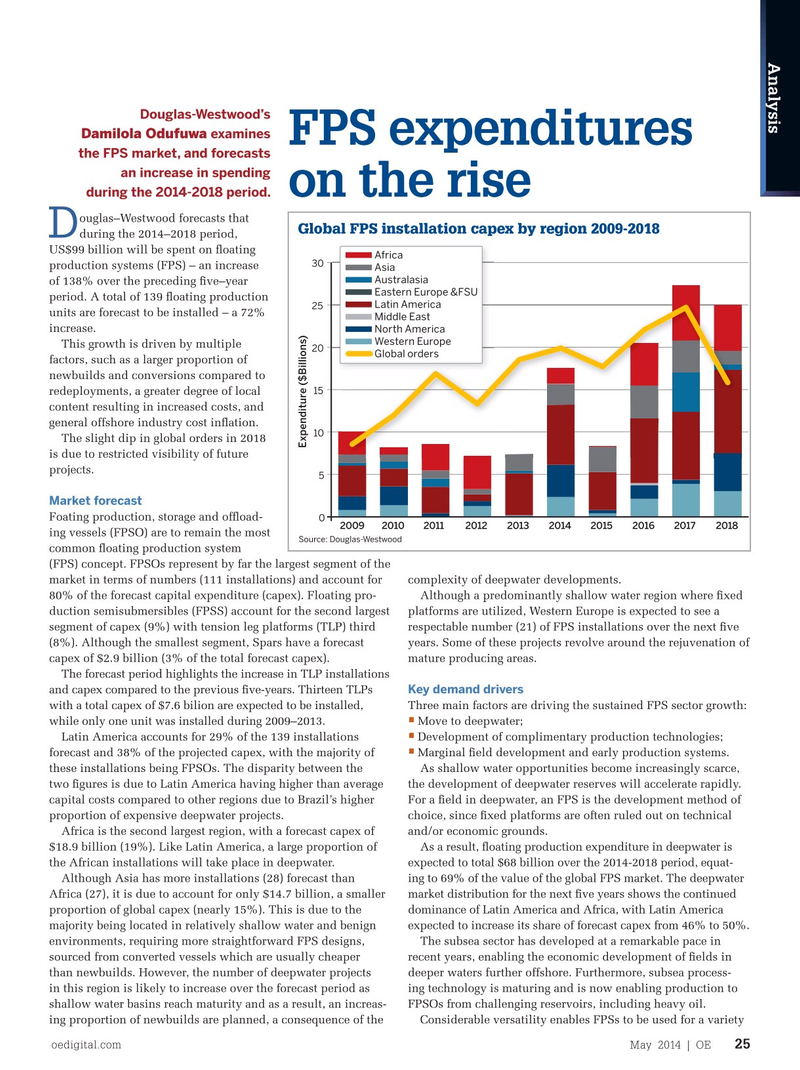
Page 23: of Offshore Engineer Magazine (May/Jun 2014)
Read this page in Pdf, Flash or Html5 edition of May/Jun 2014 Offshore Engineer Magazine
Analysis
Douglas-Westwood’s
Damilola Odufuwa examines
FPS expenditures the FPS market, and forecasts an increase in spending during the 2014-2018 period.
on the rise ouglas–Westwood forecasts that
Global FPS installation capex by region 2009-2018
D during the 2014–2018 period,
US$99 billion will be spent on ? oating
Africa 30 production systems (FPS) – an increase
Asia
Australasia of 138% over the preceding ? ve–year
Eastern Europe &FSU period. A total of 139 ? oating production
Latin America 25 units are forecast to be installed – a 72%
Middle East increase.
North America
Western Europe
This growth is driven by multiple 20
Global orders factors, such as a larger proportion of newbuilds and conversions compared to 15 redeployments, a greater degree of local content resulting in increased costs, and general offshore industry cost in? ation.
10
The slight dip in global orders in 2018
Expenditure ($Billions) is due to restricted visibility of future projects.
5
Market forecast
Foating production, storage and of? oad- 0 2009201020112012201320142015201620172018 ing vessels (FPSO) are to remain the most
Source: Douglas-Westwood common ? oating production system (FPS) concept. FPSOs represent by far the largest segment of the market in terms of numbers (111 installations) and account for complexity of deepwater developments.
80% of the forecast capital expenditure (capex). Floating pro- Although a predominantly shallow water region where ? xed duction semisubmersibles (FPSS) account for the second largest platforms are utilized, Western Europe is expected to see a segment of capex (9%) with tension leg platforms (TLP) third respectable number (21) of FPS installations over the next ? ve (8%). Although the smallest segment, Spars have a forecast years. Some of these projects revolve around the rejuvenation of capex of $2.9 billion (3% of the total forecast capex). mature producing areas.
The forecast period highlights the increase in TLP installations
Key demand drivers and capex compared to the previous ? ve-years. Thirteen TLPs with a total capex of $7.6 bilion are expected to be installed, Three main factors are driving the sustained FPS sector growth: • while only one unit was installed during 2009–2013. Move to deepwater; •
Latin America accounts for 29% of the 139 installations Development of complimentary production technologies; • forecast and 38% of the projected capex, with the majority of Marginal ? eld development and early production systems.
these installations being FPSOs. The disparity between the As shallow water opportunities become increasingly scarce, two ? gures is due to Latin America having higher than average the development of deepwater reserves will accelerate rapidly. capital costs compared to other regions due to Brazil’s higher For a ? eld in deepwater, an FPS is the development method of proportion of expensive deepwater projects. choice, since ? xed platforms are often ruled out on technical
Africa is the second largest region, with a forecast capex of and/or economic grounds. $18.9 billion (19%). Like Latin America, a large proportion of As a result, ? oating production expenditure in deepwater is the African installations will take place in deepwater. expected to total $68 billion over the 2014-2018 period, equat-
Although Asia has more installations (28) forecast than ing to 69% of the value of the global FPS market. The deepwater
Africa (27), it is due to account for only $14.7 billion, a smaller market distribution for the next ? ve years shows the continued proportion of global capex (nearly 15%). This is due to the dominance of Latin America and Africa, with Latin America majority being located in relatively shallow water and benign expected to increase its share of forecast capex from 46% to 50%.
environments, requiring more straightforward FPS designs, The subsea sector has developed at a remarkable pace in sourced from converted vessels which are usually cheaper recent years, enabling the economic development of ? elds in than newbuilds. However, the number of deepwater projects deeper waters further offshore. Furthermore, subsea process- in this region is likely to increase over the forecast period as ing technology is maturing and is now enabling production to shallow water basins reach maturity and as a result, an increas- FPSOs from challenging reservoirs, including heavy oil.
ing proportion of newbuilds are planned, a consequence of the Considerable versatility enables FPSs to be used for a variety oedigital.com May 2014 | OE 25 027_OE0514_Analysis1-DouglasWestwood.indd 25 4/18/14 6:30 PM

 22
22

 24
24